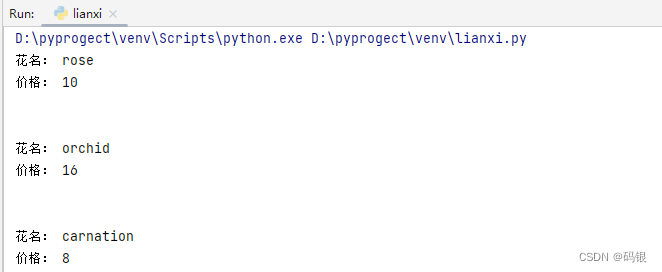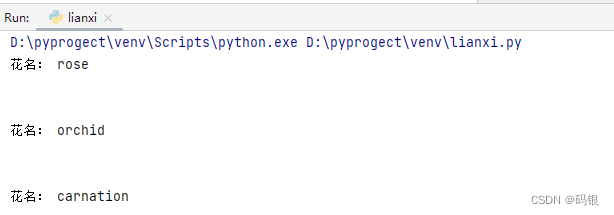一、字典的基本操作
1.定义字典
字典也是一个列表型的数据结构,字典的数据是用“{ }”装的(列表:[ ],元组:( )),字典的元素是一一对应的关系“key-value”。
格式:
Dictname={ key1:value1,...,key2:value2}
#value是任何的python的对象
#字典的元素数量也是用len()函数
多说无益,直接看例子比较清晰:
实例:
flower={'rose':10,'orchid':16,'carnation':8} tea={'红茶':30,'绿茶':20,'茉莉花茶':40} print(flower) print(tea) print("字典flower的元素数量是:",len(flower)) print("字典的数据类型:",type(tea))
2.建立空字典
实例:
print("``````````````````````````````````````````````````````````") flower={} flower['rose']=13 flower['orchid']=16 print(flower) print("``````````````````````````````````````````````````````````")
3.列出字典元素的值
格式:
flower【'rose'】
#注意列出字典元素的值要用中括号哦“[ ]”
#上面语句表达的意思是字典 flower 的 rose(key)的对应 10(value)值。
实例:
print("``````````````````````````````````````````````````````````") flower={'rose':10,'orchid':16,'carnation':8} tea={'红茶':30,'绿茶':20,'茉莉花茶':40} print("一支玫瑰的价钱是:",flower['rose']) print("红茶一袋的价钱是:",tea['红茶']) print("``````````````````````````````````````````````````````````")
如果有两个“rose”,两个“红茶”呢,元素对应的值(value)是哪个呢?
print("``````````````````````````````````````````````````````````") flower={'rose':10,'orchid':16,'carnation':8,'rose':15} tea={'红茶':30,'绿茶':20,'茉莉花茶':40,'红茶':13} print("一支玫瑰的价钱是:",flower['rose']) print("红茶一袋的价钱是:",tea['红茶']) print("``````````````````````````````````````````````````````````")
如上所示,字典中的元素对应值被后面的值占领了。
4.增加字典元素
实例:
print("``````````````````````````````````````````````````````````") flower={'rose':10,'orchid':16,'carnation':8} tea={'红茶':30,'绿茶':20,'茉莉花茶':40} flower['tuilp']=13 print(flower) print("``````````````````````````````````````````````````````````")
5.更改元素内容
实例:
print("``````````````````````````````````````````````````````````") flower={'rose':10,'orchid':16,'carnation':8} tea={'红茶':30,'绿茶':20,'茉莉花茶':40} flower['rose']=13 print(flower) print("``````````````````````````````````````````````````````````")
6.删除字典(特定元素)
删除元素实例:
print("``````````````````````````````````````````````````````````") flower={'rose':10,'orchid':16,'carnation':8} tea={'红茶':30,'绿茶':20,'茉莉花茶':40} del flower['rose'] print(flower) print("``````````````````````````````````````````````````````````")
删除字典实例:
print("``````````````````````````````````````````````````````````") flower={'rose':10,'orchid':16,'carnation':8} del flower print(flower) print("``````````````````````````````````````````````````````````")
7. 字典的复制
print("``````````````````````````````````````````````````````````") flower={'rose':10,'orchid':16,'carnation':8} copyflower=flower.copy() print(flower) print(copyflower) print("``````````````````````````````````````````````````````````")
二、遍历字典
1.遍历字典的key-value
flower={'rose':10, 'orchid':16, 'carnation':8} for flowers,price in flower.items(): print("花名:",flowers) print("价格:",price) print("\n")
2.遍历字典的键(key)
flower={'rose':10, 'orchid':16, 'carnation':8} for flowers in flower.keys(): print("花名:",flowers) print("\n")
没有keys()函数也行:
1. flower={'rose':10, 2. 'orchid':16, 3. 'carnation':8} 4. for flowers in flower: 5. print("花名:",flowers)
3.遍历字典的值(value)
1. flower={'rose':10, 2. 'orchid':16, 3. 'carnation':8} 4. for flowers in flower.values(): 5. print("价格:",flowers)
4.字典里面放字典
实例:人物介绍
role={ '鲁班':{ '技能':'土木建筑', '职业':'工匠' }, '钟无艳':{ '技能':'出谋划策', '职业':'中国古代四大丑女之一' }, '蔡文姬':{ '技能':'琴棋书画', '职业':'董祀之妻' } } for a,b in role.items(): print("姓名:",a) print("介绍:",b)
5.简单介绍下函数
len():求元素个数
get():搜寻字典的key
格式:返回值=字典名.get('key')
pop():删除元素
格式:返回值=字典名.pop('key')













